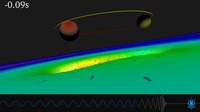
Photo from wikipedia
Fluctuations of gravitational forces cause so-called Newtonian noise (NN) in gravitational-wave detectors which is expected to limit their low-frequency sensitivity in upcoming observing runs. Seismic NN is produced by seismic… Click to show full abstract
Fluctuations of gravitational forces cause so-called Newtonian noise (NN) in gravitational-wave detectors which is expected to limit their low-frequency sensitivity in upcoming observing runs. Seismic NN is produced by seismic waves passing near a detector’s suspended test masses. It is predicted to be the strongest contribution to NN. Modeling this contribution accurately is a major challenge. Arrays of seismometers were deployed at the Virgo site to characterize the seismic field near the four test masses. In this paper, we present results of a spectral analysis of the array data from one of Virgo’s end buildings to identify dominant modes of the seismic field. Some of the modes can be associated with known seismic sources. Analyzing the modes over a range of frequencies, we provide a dispersion curve of Rayleigh waves. We find that the Rayleigh speed in the NN frequency band 10–20 Hz is very low (≲100 m s−1), which has important consequences for Virgo’s seismic NN. Using the new speed estimate, we find that the recess formed under the suspended test masses by a basement level at the end buildings leads to a 10 fold reduction of seismic NN.
Journal Title: Classical and Quantum Gravity
Year Published: 2021
Link to full text (if available)
Share on Social Media: Sign Up to like & get
recommendations!